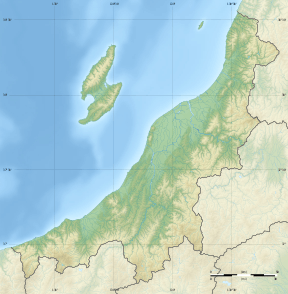Furutsu Hachimanyama Site
Furutsu Hachimanyama Site (古津八幡山遺跡, Furutsu Hachimanyama iseki) is an archaeological park containing the remnants of a late Yayoi period moated settlement with three Kofun tombs located in Akiha-ku, Niigata in the Hokuriku region of Japan. The site was designated a National Historic Site of Japan in 2005.[1]
古津八幡山遺跡 | |
Furutsu Hachimanyama kofun | |
 Furutsu Hachimanyama Site  Furutsu Hachimanyama Site (Japan) | |
| Location | Akiha-ku, Niigata, Japan |
|---|---|
| Region | Hokuriku region |
| Coordinates | 37°45′50″N 139°06′55″E |
| Type | settlement, kofuen |
| History | |
| Founded | Yayoi period |
| Site notes | |
| Ownership | National Historic Site |
| Public access | Yes |
Overview
The site was discovered in 1987 during the construction of the Ban-etsu Expressway. It consists of a late Yayoi period moated settlement on a slight elevation above the Niigata Plain. The settlement was surrounded by a V-shaped moat, intermittent in places, double in others, with a depth three meters and width of two meters. The soil excavated from the moats were used to form a rudimentary rampart. Within the moat were 45 raised-floor dwellings, rectangular, measuring four to five meters on each side, with a hearth in the center and a drain groove. Some 32 pit dwellings have also been identified. The settlement also encompassed two rectangular tumuli, and a short distance away, a keyhole-shaped kofun, with a 60 meter diameter round portion, orientated to the north.
Some artifacts uncovered at the site are on display at the Yayoi Hill Museum at site, and some faux representations of pit houses have been built.
See also
| Wikimedia Commons has media related to Furutsu-Hachimanyama Kofun. |
References
- "古津八幡山遺跡" (in Japanese). Agency for Cultural Affairs.
External links
- Niigata city home page (in Japanese)
- Akiha-ku, Niigata page(in Japanese)